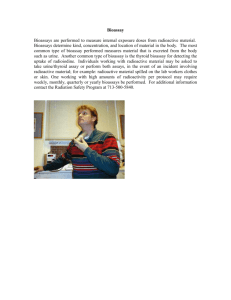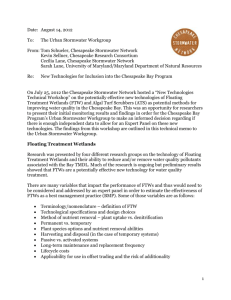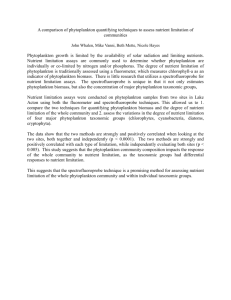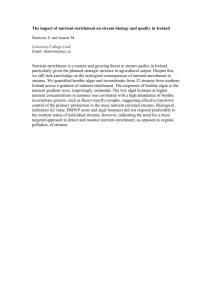Nutrient Limitation Bioassay- Teacher Guide
advertisement
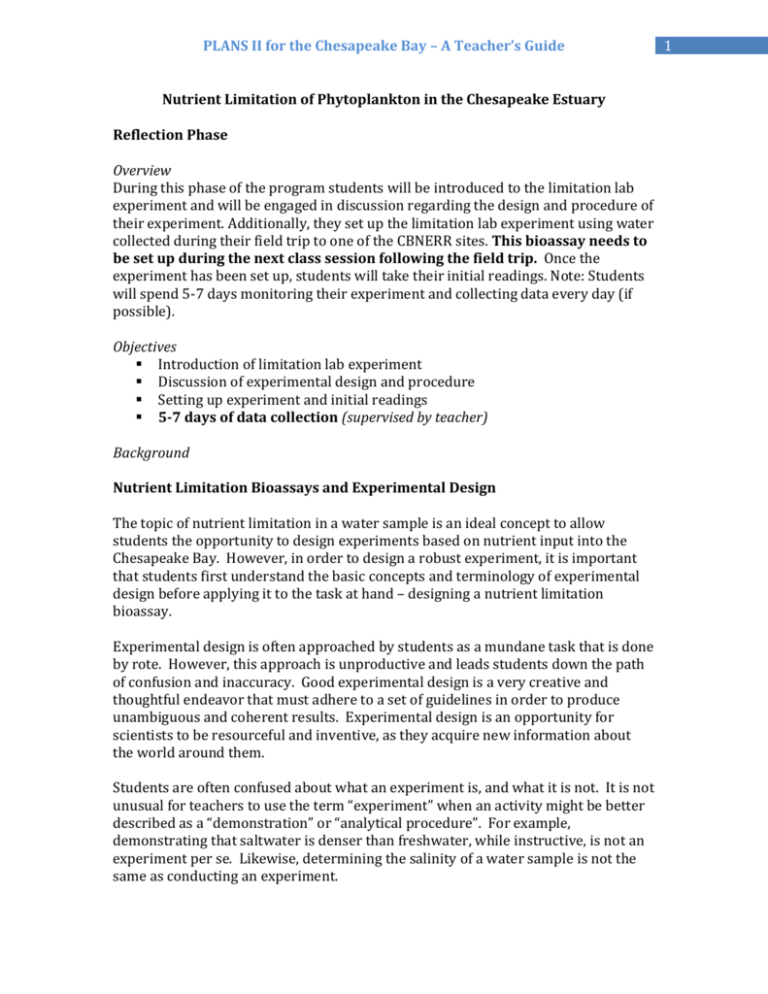
PLANS II for the Chesapeake Bay – A Teacher’s Guide Nutrient Limitation of Phytoplankton in the Chesapeake Estuary Reflection Phase Overview During this phase of the program students will be introduced to the limitation lab experiment and will be engaged in discussion regarding the design and procedure of their experiment. Additionally, they set up the limitation lab experiment using water collected during their field trip to one of the CBNERR sites. This bioassay needs to be set up during the next class session following the field trip. Once the experiment has been set up, students will take their initial readings. Note: Students will spend 5-7 days monitoring their experiment and collecting data every day (if possible). Objectives Introduction of limitation lab experiment Discussion of experimental design and procedure Setting up experiment and initial readings 5-7 days of data collection (supervised by teacher) Background Nutrient Limitation Bioassays and Experimental Design The topic of nutrient limitation in a water sample is an ideal concept to allow students the opportunity to design experiments based on nutrient input into the Chesapeake Bay. However, in order to design a robust experiment, it is important that students first understand the basic concepts and terminology of experimental design before applying it to the task at hand – designing a nutrient limitation bioassay. Experimental design is often approached by students as a mundane task that is done by rote. However, this approach is unproductive and leads students down the path of confusion and inaccuracy. Good experimental design is a very creative and thoughtful endeavor that must adhere to a set of guidelines in order to produce unambiguous and coherent results. Experimental design is an opportunity for scientists to be resourceful and inventive, as they acquire new information about the world around them. Students are often confused about what an experiment is, and what it is not. It is not unusual for teachers to use the term “experiment” when an activity might be better described as a “demonstration” or “analytical procedure”. For example, demonstrating that saltwater is denser than freshwater, while instructive, is not an experiment per se. Likewise, determining the salinity of a water sample is not the same as conducting an experiment. 1 PLANS II for the Chesapeake Bay – A Teacher’s Guide 2 So what is an experiment? The dictionary defines the term experiment, in part, as “an operation or procedure carried out under controlled conditions in order to discover an unknown effect or law; to test a hypothesis”. It is the hypothesis testing aspect of this definition that is especially critical. Making observations and forming a hypothesis leads to an iterative process by which the hypothesis can be confirmed or refined (Figure 1). A hypothesis is a statement - not a question or objective - that describes some aspect of the natural world. It is Figure 1. A schematic of the experimental process. usually based on initial observations. For example in the case of nutrient limitation bioassays, the hypothesis could be stated as: “Either nitrogen or phosphorus is the macronutrient controlling algal production in my water sample”. Based on this hypothesis you could make the following predictions: 1) “Algal growth will be enhanced by the addition of excess nitrogen.” or 2) “Algal growth will be enhanced by the addition of excess phosphorus.” The next step is to design an experiment to test these predictions. Experiments are designed so that only one factor varies. This is the manipulated (or independent) variable. In our example this would be the addition of excess nitrogen or phosphorus added to each test tube. The additions of different nutrients are called treatments. During the experiment we would monitor algal growth in each tube. This is our observed (or dependent) variable. All other factors that could conceivably affect the outcome of the experiment must be the same among the treatments. These are called constants. In our example, constants would be such factors as the initial amount of water in the tubes; the temperature at which the tubes are incubated; the amount of light exposure provided each tube; and so forth. It is often advisable to monitor constants during an experiment to document that they did indeed remain unchanged. Well designed experiments also contain controls. These act as internal tests of the validity of your design. Positive controls are designed to determine whether the experimental procedures are capable of observing the predicated effect (e.g., enhanced algal growth in the presence of excess nutrients – both N and P). Negative controls confirm that the procedure is not observing an unrelated effect (e.g., enhanced algal growth unconnected to nutrient additions). In our example, additional test tubes that have both Figure 2. A typical experimental design for a nutrient N and P added to them are positive controls. limitation bioassay. Negative controls would be tubes containing PLANS II for the Chesapeake Bay – A Teacher’s Guide our water sample but no additional nutrients. The entire experimental design scheme is summarized in Figure 2. Another important component of good experimental design is replication. Each control and treatment within an experiment should be replicated a number of times. Replication allows us to document and quantify the variability of our experimental system in response to the manipulation that we have just performed. How many replicates are necessary? There is no magic number of replicates. Generally, it’s advisable to do as many as your time and resources will allow. Classroom time and resources are often at a premium; however, try to perform at least some replication. Lastly, it is important to point out that our classroom experiment is trying to measure nutrient limitation in a natural water sample collected from a much larger aquatic system. In our case, the test tube is considered to be an experimental model of one of these much larger systems. Models are customarily used to provide replicates of larger, more complex natural systems. However, the model and the natural system will differ in many ways. For example, water in a lake, river, or bay: contains many more organisms than are found in the test tube model receives rainfall and runoff continuously, unlike the test tube model interacts with bottom sediments not found in the test tube model is subject to different temperature and light conditions than the test tube model These differences may or may not be important to the hypothesis being tested. However, it is critical for your students to consider each of them (and possibly others) when interpreting the findings of your classroom experiment and trying to infer their results to the larger ecosystem. Measuring Algal Biomass Changes in the biomass (living material) of algae from one time to another can be a way of monitoring algal growth. There are many methods for determining the biomass of algal samples. For instance, you could count the number of cells in a sample of the algal culture using a microscope and counting chamber. Or you could determine the weight of your algal sample, if it was large enough to be weighed reliably. Alternately, you could express biomass as the amount of a critical component in the algae such as chlorophyll. Chlorophyll content in a sample of living algae (in vivo) can be measured easily and with great sensitivity by applying a fluorescence technique. The fluorescence method is based on the fact that chlorophyll in algal cells will absorb energy from one wavelength of light (the “excitation” wavelength) and then emit light of another wavelength (the “emission” wavelength). See the following diagram. 3 PLANS II for the Chesapeake Bay – A Teacher’s Guide Light Detector Light Source 450 nm 665 nm Excitation Filter (665nm) Algal Sample Emission Filter (460 nm) The amount of light emitted from the sample is proportional to the amount of chlorophyll in the sample. We will use a piece of laboratory equipment known as a fluorometer to make such measurements. The fluorometer (either an Aquafluor™ or Vernier Spectro-Vis+) hand-held is specially constructed to take a single reading at one time. This instrument is capable of being used in the laboratory or field. Materials Needed Limitation Bioassay Kit(s) – provided by CBNERR staff Constructed Light Box(es) – provided by CBNERR staff Hand-held fluorometer and cuvettes - provided by CBNERR staff Student Handout for Nutrient Limitation Bioassay Procedure - downloadable from the PLANS II website. Class Data Sheet (for recording all fluorometric readings during the Bioassay) - downloadable from the PLANS II website. Preparation 4 Construct the light box using the materials provided by CBNERR staff and the instruction sheet on the PLANS II website under. Note: You may want to enlist students in this task; however, this will require additional time. Alternately, the CBNERR staff may be able to provide the loan of a constructed light-box. Make copies of the student handout: Nutrient Limitation Bioassay Procedure. Make copies of the class data sheet Make copies of the optional Student Reading: Understanding Nutrient Limitation. PLANS II for the Chesapeake Bay – A Teacher’s Guide Make copies of the Check for Understanding page (last page of this document). Lab Procedure Preparing the Nutrient Solutions: (Note: These solutions should be prepared prior to the class session during which students will set up the bioassay.) During this experiment we will use similar concentrations of nutrients found in a commonly used algal growth media. The concentrations of N and P are 75 g/l and 5 g/l respectively. Prepare 100ml of a 1 molar solution of the following: Nutrient Weight needed for 1 molar solution Sodium Nitrate 8.49 g Trisodium Phosphate 16.39 g Add to this much water 100 ml 100 ml The concentration of phosphate will need to be diluted before adding to your test tubes. For phosphate dilutions: add 1 ml of your stock 1M phosphate solution into a volumetric flask and QS (Quantify Sufficient/bring it up to) to 250ml. This will create a 0.004 M phosphate solution that students will use in the bioassay. Transfer this into a glass bottle for long term storage and label appropriately. No dilutions of Sodium Nitrate are necessary. You will use the 1 molar solution in your experiment. Label your stock solutions appropriately. Classroom Procedure Begin with a Discussion of Experimental Design: (The length and detail needed in this discussion will vary depending upon whether this material has been covered previously in the class.) 1. Ask students to describe the basic steps in the experimental method. As they use the terminology of experimental design, probe their understanding of these terms or add the proper terms to the discussion as needed (See italicized terms in the Background). 2. Have teams of students brainstorm the best design for a nutrient limitation bioassay given the materials available in the Limitation Bioassay Kit. Guide their discussions so that they formulate an experimental design similar to 5 PLANS II for the Chesapeake Bay – A Teacher’s Guide that described in the Background. Consider the amount of replication that will be possible considering time and resources available. Set up the Bioassay: 3. Each team of students should set up one replicate of each blank, control and treatment in the Bioassay (5 tubes in total). Provide copies of the student handout of the Nutrient Limitation Bioassay Procedure to be used as a precise guide in setting up the experiment. Review this handout to familiarize yourself with the details of the procedure. Monitor the Bioassay: 4. Instruct students in the proper use of the fluorometer. Demonstrate the use of the instrument. 5. Have each team of students measure and record their initial fluorometric readings on the class data sheet. 6. Set up a schedule for students to make periodic readings of their samples, daily (if possible), until at least some of the tubes achieve very dense algal growth (total monitoring time not to exceed 7 days). All data should be collected on the class data sheet so that it can be copied and distributed to all students at the completion of the experiment. Check for Understanding – Teacher Guide Provide your students with the questions in the Check for understanding section of this document. Dr. Jenny Tulka, just set up a similar bioassay to yours. Instead of nutrient manipulation, Jenny is interested in the affect heavy metals (copper sulfate and magnesium sulfate) has on the growth of phytoplankton. With this in mind answer the following questions. 1. In the space below write Jenny’s hypothesis/hypotheses? Answer: 1: The addition of both copper sulfate and magnesium sulfate will significantly reduce phytoplankton growth compared to the addition of either copper sulfate or magnesium sulfate 2: The addition of a critical concentration of heavy metals will significantly reduce phytoplankton growth 2. Is the addition of heavy metals the independent or dependent variable (circle choice) Answer: independent 3. Is the change in algal growth as a result of the addition of heavy metals the independent or dependent variable (circle choice) Answer: dependent 6 PLANS II for the Chesapeake Bay – A Teacher’s Guide 4. What would be the positive control? Answer: The addition of both heavy metals to the sample of phytoplankton 5. What would be the negative control? Answer: The omission of heavy metals to the sample of phytoplankton 7 PLANS II for the Chesapeake Bay – A Teacher’s Guide Checking for Understanding Dr. Jenny Tulka, just set up a similar bioassay to yours. Instead of nutrient manipulation, Jenny is interested in the affect heavy metals (copper sulfate and magnesium sulfate) has on the growth of phytoplankton. With this in mind answer the following questions. 1. In the space below write Jenny’s hypothesis/hypotheses? 2. Is the addition of heavy metals the independent or dependent variable (circle choice) 3. Is the change in algal growth as a result of the addition of heavy metals the independent or dependent variable (circle choice) 4. What would be the positive control? 5. What would be the negative control? 8
